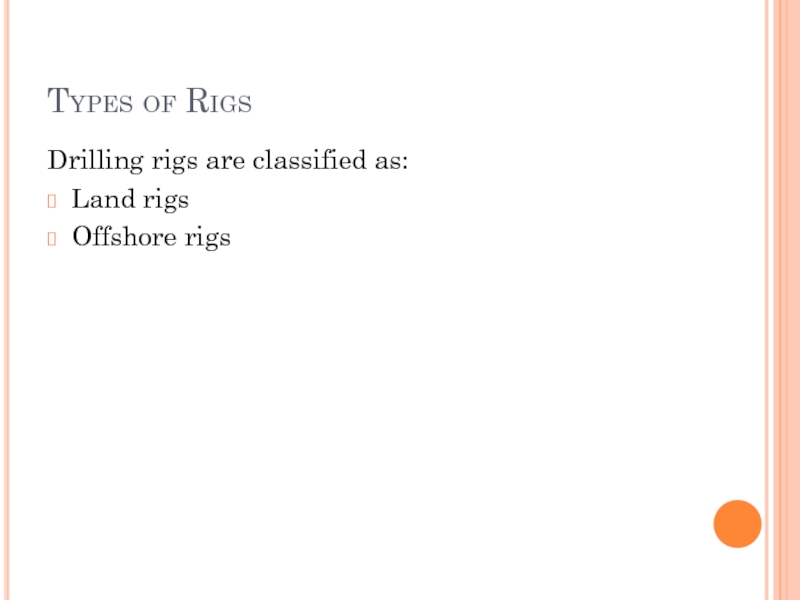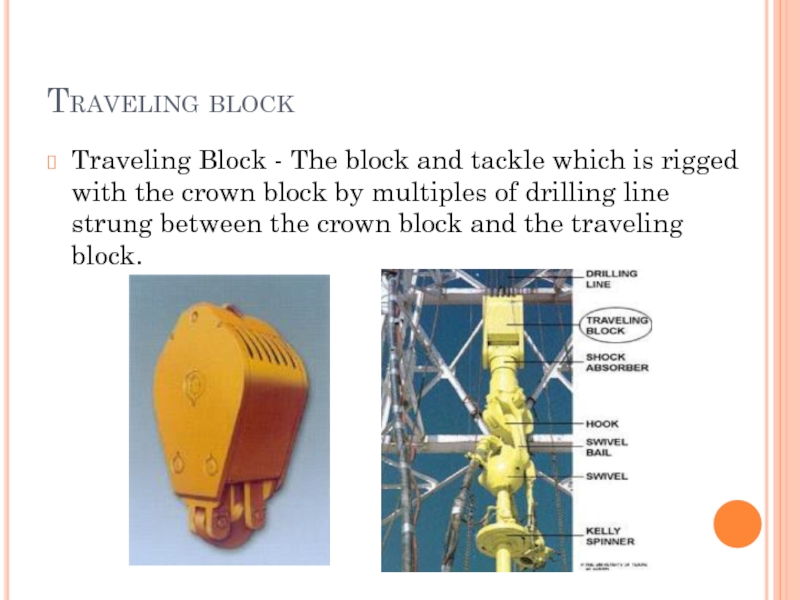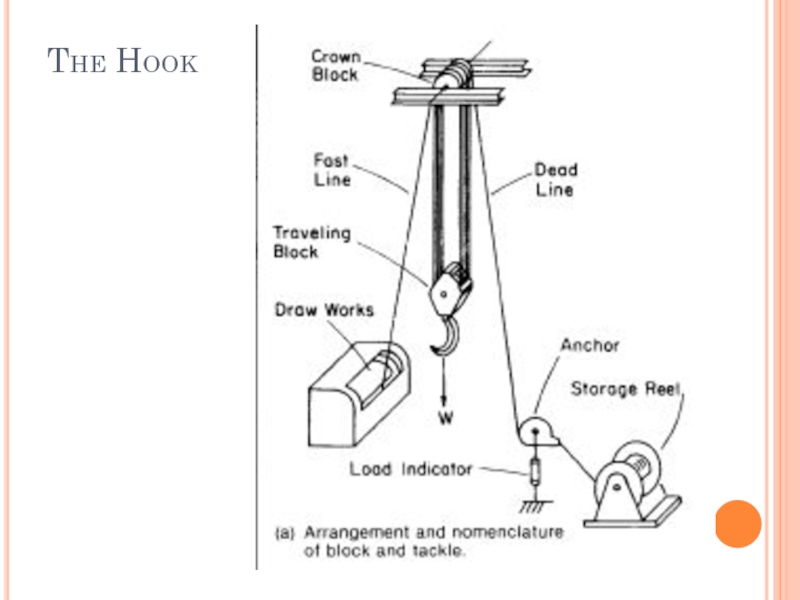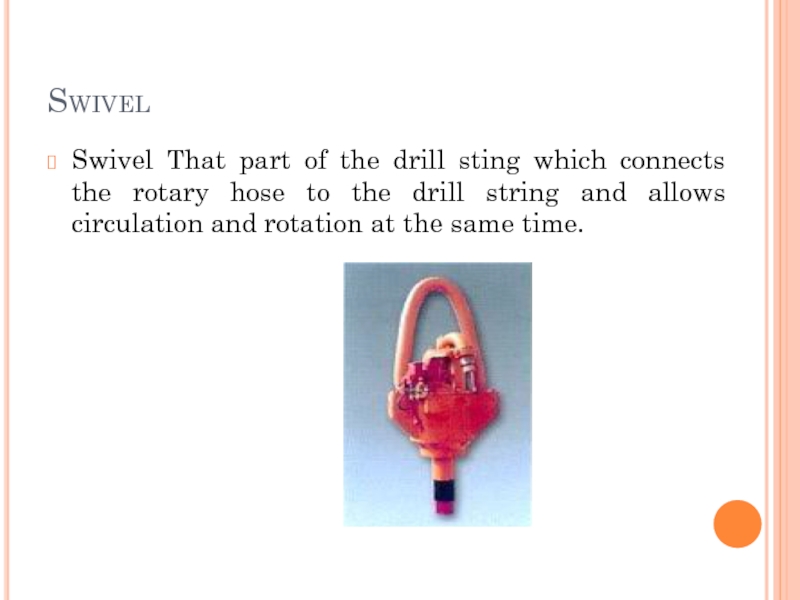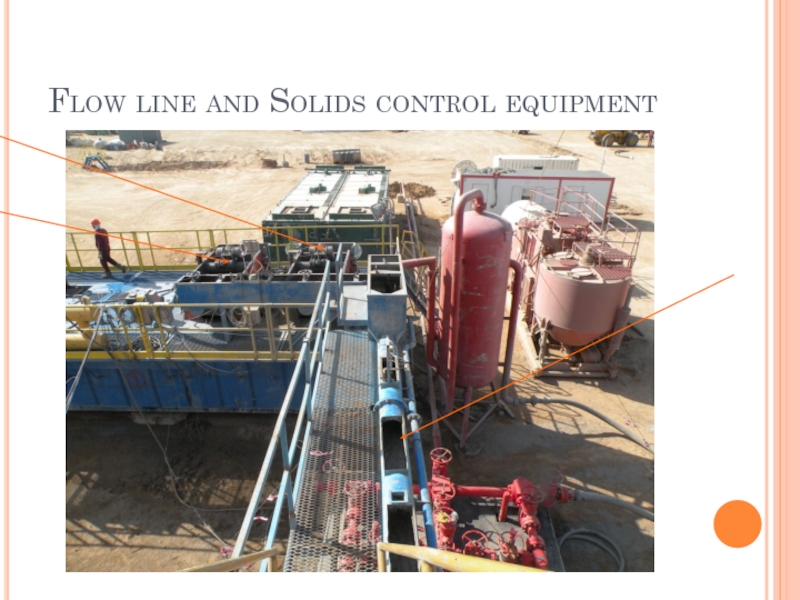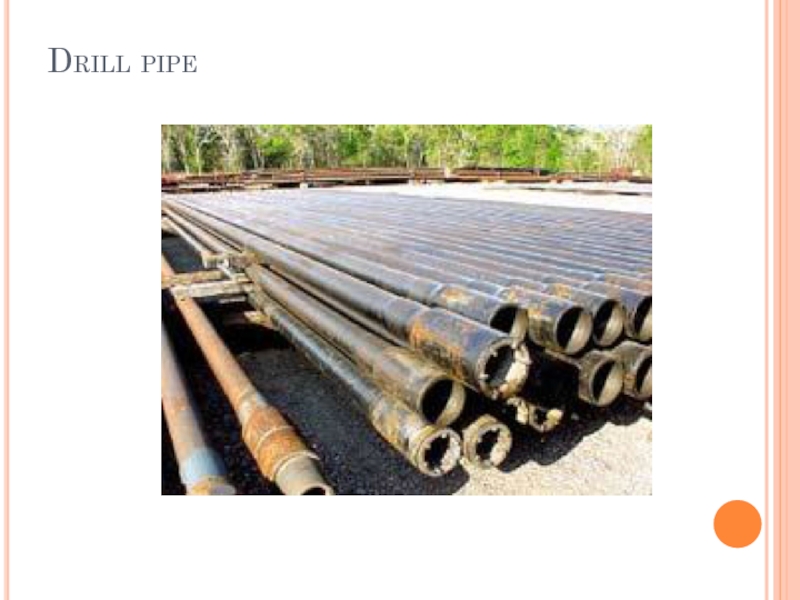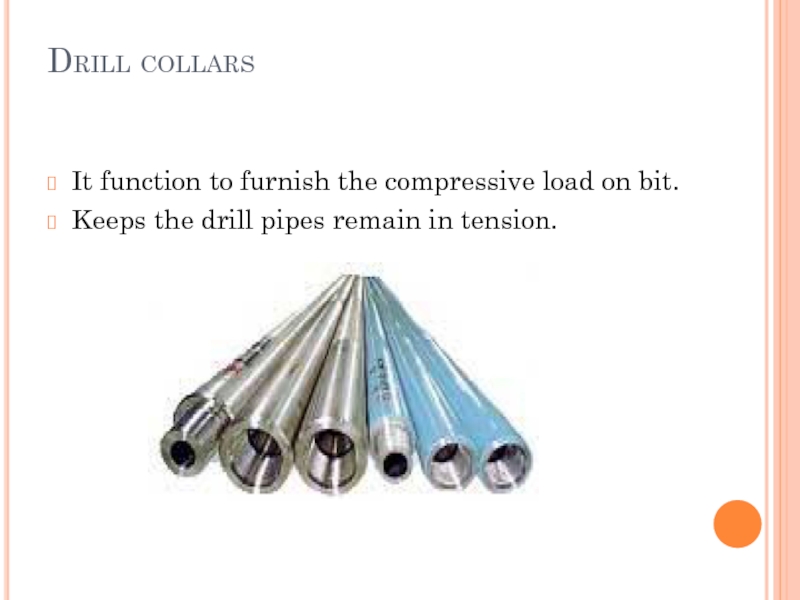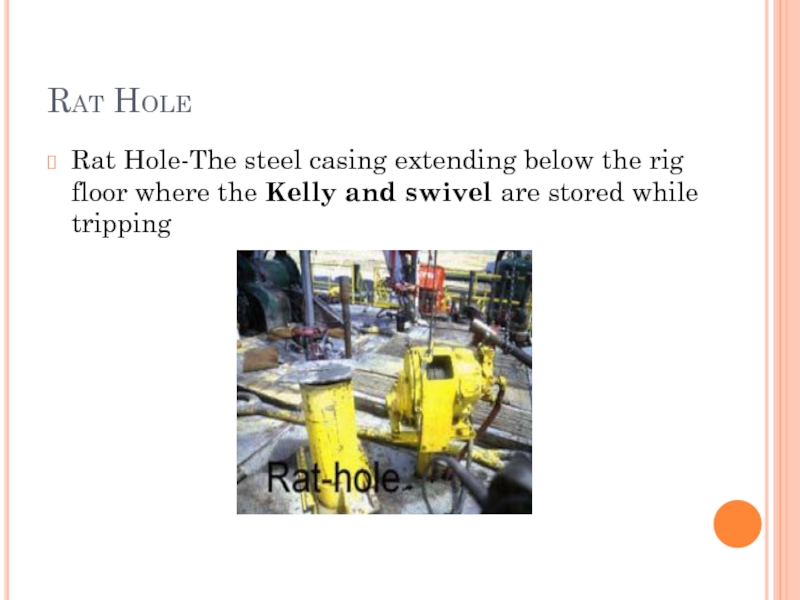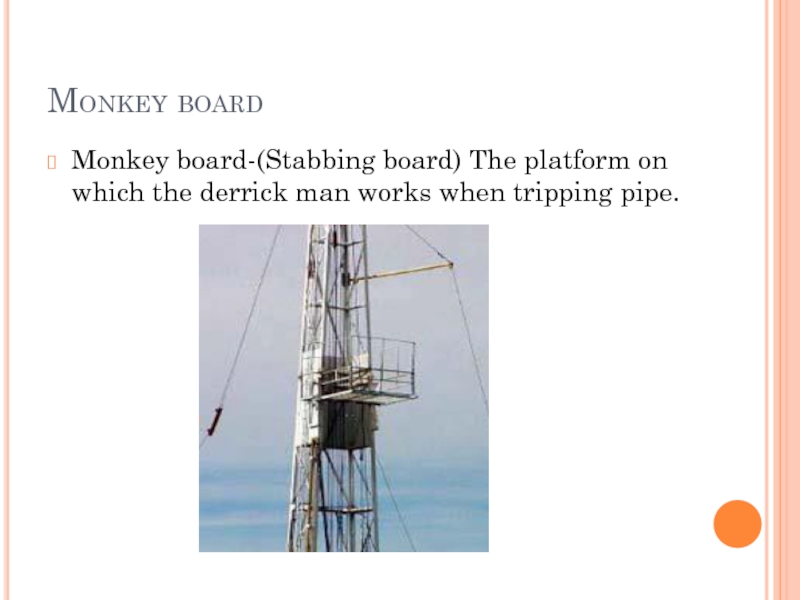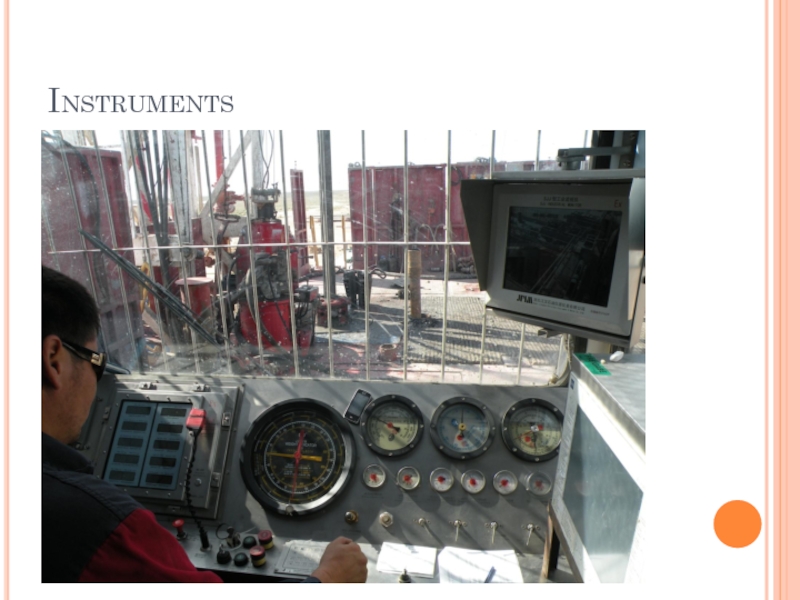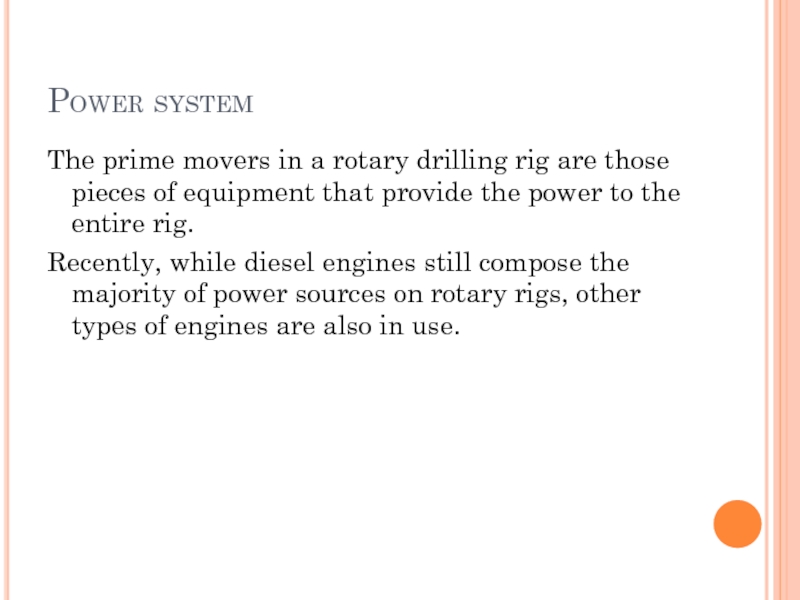by:
Bagdat Mombekov, Lector
- Главная
- Разное
- Дизайн
- Бизнес и предпринимательство
- Аналитика
- Образование
- Развлечения
- Красота и здоровье
- Финансы
- Государство
- Путешествия
- Спорт
- Недвижимость
- Армия
- Графика
- Культурология
- Еда и кулинария
- Лингвистика
- Английский язык
- Астрономия
- Алгебра
- Биология
- География
- Детские презентации
- Информатика
- История
- Литература
- Маркетинг
- Математика
- Медицина
- Менеджмент
- Музыка
- МХК
- Немецкий язык
- ОБЖ
- Обществознание
- Окружающий мир
- Педагогика
- Русский язык
- Технология
- Физика
- Философия
- Химия
- Шаблоны, картинки для презентаций
- Экология
- Экономика
- Юриспруденция
Drilling rigs and rig types. Rig components презентация
Содержание
- 1. Drilling rigs and rig types. Rig components
- 2. A Drilling Rig A drilling rig is
- 3. Types of Rigs Drilling rigs are classified as: Land rigs Offshore rigs
- 4. Offshore rigs There are two types of
- 5. Floating rigs:
- 6. Floating rigs:
- 7. Floating rigs:
- 8. Bottom-supported rigs:
- 9. Bottom-supported rigs:
- 10. Bottom-supported rigs:
- 11. Rig components The major components that need
- 12. Hoisting System The main objective of this
- 13. Hoisting System
- 14. Crown Block
- 15. Traveling block Traveling Block - The block
- 16. Drawworks
- 17. Hoisting System
- 18. Dead Line Anchor
- 19. The Hook
- 20. Rotating System The main objectives of
- 21. Rotary table
- 22. The Kelly/Top Drive The Kelly/ top
- 23. Swivel Swivel That part of the drill
- 24. Top drive What is it? – Watch
- 25. Circulating System The main objective of circulation
- 26. Functions of Drilling Fluids: Lift-up cuttings
- 27. Circulating System The principal components of the
- 28. Mud pumps
- 29. Mud pumps Mud pumps are used for
- 30. Mud Piston - Liner
- 31. Flow line and Solids control equipment
- 32. Mud pits and Solids control equipment
- 33. Mud mixing hopper
- 34. Waste pit
- 35. Tubular Goods The components of the
- 36. Drill pipe
- 37. Drill collars It function to
- 38. STABILIZERS
- 39. Pressure Control Equipment
- 40. Pressure Control Equipment 1. Diverter if required,
- 42. Choke line
- 43. Drill pipe blowout preventer
- 44. Rig Floor Equipment and Instruments
- 45. Tongs Tongs-Large wrench-like devices that
- 46. Slips Slips-Latch around the drill pipe
- 47. Elevators Elevators-The elevators are used for latching
- 48. Rat Hole Rat Hole-The steel casing extending
- 49. Mouse Hole-A section of steel casing
- 50. Monkey board Monkey board-(Stabbing board) The platform
- 52. Instruments There are several instruments on
- 53. Instruments
- 54. Instruments
- 55. What is this?
- 56. Power system The prime movers in a
- 57. Power system Some rotary rigs may
- 58. Thank you a lot for listening to my talk!
Слайд 1Drilling rigs and rig types. Rig components
Prepared by:
Kanat Suleimen, Senior-lector
Modified
Слайд 2A Drilling Rig
A drilling rig is a device used to drill,
case and cement water, oil and gas wells.
Слайд 4Offshore rigs
There are two types of offshore rigs:
1. Floating rigs:
• Semisubmersible
•
Drillships
2. Bottom-supported rigs: There are three types:
• Jack-ups
• Platform
•Barge
2. Bottom-supported rigs: There are three types:
• Jack-ups
• Platform
•Barge
Слайд 11Rig components
The major components that need to be selected and sized
for the purpose of rig sizing are:
1. Hoisting System
2. Rotating System
3. Circulating System
4. Tubular Goods
5. Well control system
6. Derrick Capacity And Substructure
7. Power Requirements for the above
1. Hoisting System
2. Rotating System
3. Circulating System
4. Tubular Goods
5. Well control system
6. Derrick Capacity And Substructure
7. Power Requirements for the above
Слайд 12Hoisting System
The main objective of this system is to provide lifting
and dropping force towards drill string and any components around rig floor.
Drawworks
Crown Block
Dead Line Anchor
Travelling Block
The Hook
Drilling Line
Drawworks
Crown Block
Dead Line Anchor
Travelling Block
The Hook
Drilling Line
Слайд 15Traveling block
Traveling Block - The block and tackle which is rigged
with the crown block by multiples of drilling line strung between the crown block and the traveling block.
Слайд 20Rotating System
The main objectives of this system is to create rotation
force towards drill bit at the bottom hole and provide helps when tightening and loosing pipe connection.
1. Rotary table
2. Top Drive (this is equivalent to the Kelly and rotary table, i.e. either top drive or Kelly/rotary table
3. Kelly
4. Swivel
5. Rotary hose
1. Rotary table
2. Top Drive (this is equivalent to the Kelly and rotary table, i.e. either top drive or Kelly/rotary table
3. Kelly
4. Swivel
5. Rotary hose
Слайд 22The Kelly/Top Drive
The Kelly/ top drive provide the rotation required for
rock breakage (drilling). The Kelly is the rotating link between the rotary table and the drill string.
Слайд 23Swivel
Swivel That part of the drill sting which connects the rotary
hose to the drill string and allows circulation and rotation at the same time.
Слайд 24Top drive
What is it? – Watch the video…
The top drive is
basically a combined rotary table and Kelly. It is powered by a separate motor and transmits rotation to the drill string directly without the need for a rotary table.
Слайд 25Circulating System
The main objective of circulation system is to pump fluid
through the whole active fluid system. The complete circuitous path that the drilling fluid travels starting at the:
main rig pumps
surface piping
standpipe
kelly hose (rotary)
kelly
drillpipe
drill collars
bit nozzles
openhole and casing strings
flowline
mud-cleaning equipment
mud tanks
positive displacement main rig pumps
main rig pumps
surface piping
standpipe
kelly hose (rotary)
kelly
drillpipe
drill collars
bit nozzles
openhole and casing strings
flowline
mud-cleaning equipment
mud tanks
positive displacement main rig pumps
Слайд 26
Functions of Drilling Fluids:
Lift-up cuttings
To cover the underground pressure
To restrain
the well bore
To create mud cake and prevent filtrate loss
To lubricate drill bit and drill string
Down hole information gathering media and well logging
To transfer hydraulic force to downhole motor
To create mud cake and prevent filtrate loss
To lubricate drill bit and drill string
Down hole information gathering media and well logging
To transfer hydraulic force to downhole motor
Слайд 27Circulating System
The principal components of the rig circulating system include:
Mud pumps
Mud
pits
Mud mixing equipment
Solids control equipment
Mud mixing equipment
Solids control equipment
Слайд 29Mud pumps
Mud pumps are used for circulating the drilling fluid down
the drill pipe and out of the annulus. These are high-pressure and high-volume pumps. They can be double-acting duplex pumps or single-acting triplex pumps.
A. The double-acting duplex pump has four pumping actions per pump cycle.
B. The single-acting triplex pump has three pumping actions per pump cycle.
A. The double-acting duplex pump has four pumping actions per pump cycle.
B. The single-acting triplex pump has three pumping actions per pump cycle.
Слайд 35Tubular Goods
The components of the drill string are:
1. Drill pipe
2. Drill
collars
2. Accessories including:
• Heavy-walled drill pipe
• Stabilizers
•Reamers
• Directional control equipment
2. Accessories including:
• Heavy-walled drill pipe
• Stabilizers
•Reamers
• Directional control equipment
Слайд 37Drill collars
It function to furnish the compressive load on bit.
Keeps the
drill pipes remain in tension.
Слайд 40Pressure Control Equipment
1. Diverter if required, usually for offshore operations during
the drilling of top or surface hole. Make sure the
diverter discharge line is 12” or above.
2. Annular preventer
3. Ram preventers (determine minimum size of rams
required to suit the drillstring)
4. Blind or Shear rams
5. Choke manifold
6. HCR valves
7. Choke and Kill lines
8. Accumulator and BOP Control System (Koomey Unit)
diverter discharge line is 12” or above.
2. Annular preventer
3. Ram preventers (determine minimum size of rams
required to suit the drillstring)
4. Blind or Shear rams
5. Choke manifold
6. HCR valves
7. Choke and Kill lines
8. Accumulator and BOP Control System (Koomey Unit)
Слайд 44 Rig Floor Equipment and Instruments
This is a large list and
includes:
1. Tongs
2. Iron Roughneck
3. Slips
4. Bit breakers
5. Lift Nipples
6. Mud bucket
7. Elevators
8. Safety clamps
1. Tongs
2. Iron Roughneck
3. Slips
4. Bit breakers
5. Lift Nipples
6. Mud bucket
7. Elevators
8. Safety clamps
Слайд 45Tongs
Tongs-Large wrench-like devices that are used to tighten up and
break out tool joints or connections. The tongs are connected to the breakout and make up catheads. Hydraulic tongs are generally used to make up casing and tubing, deriving power from a hydraulic unit.
Слайд 46Slips
Slips-Latch around the drill pipe and seat in the rotary bushing
in the rotary table. The slips support and transmit the weight of the drill string to the rotary table while making a connection or tripping pipe.
Слайд 47Elevators
Elevators-The elevators are used for latching on to the tool joint
or lift sub of the drill pipe or drill collars.This enables the lifting and lowering of the drill string while making a trip. The elevators are connected to the hoisting system(traveling block) by means of bails.
Слайд 48Rat Hole
Rat Hole-The steel casing extending below the rig floor where
the Kelly and swivel are stored while tripping
Слайд 49
Mouse Hole-A section of steel casing that extends below the rig
floor where drill pipe is placed to be made up in the drill string or to the Kelly. It is further used in laying down drill pipe.
Слайд 50Monkey board
Monkey board-(Stabbing board) The platform on which the derrick man
works when tripping pipe.
Слайд 52Instruments
There are several instruments on the rig floor including:
• Standpipe pressure
gauge
• Weight indicator
• Pump speed
• Pit level indicator
• Gas detectors
• Weight indicator
• Pump speed
• Pit level indicator
• Gas detectors
Слайд 56Power system
The prime movers in a rotary drilling rig are those
pieces of equipment that provide the power to the entire rig.
Recently, while diesel engines still compose the majority of power sources on rotary rigs, other types of engines are also in use.
Recently, while diesel engines still compose the majority of power sources on rotary rigs, other types of engines are also in use.
Слайд 57Power system
Some rotary rigs may use electricity directly from power
lines. Most rotary rigs these days require 1,000 to 3,000 horsepower, while shallow drilling rigs may require as little as 500 horsepower.
The energy from these prime movers is used to power the rotary equipment, the hoisting equipment, and the circulating equipment.
The energy from these prime movers is used to power the rotary equipment, the hoisting equipment, and the circulating equipment.


